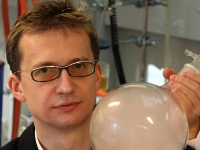Progress in metathesis chemistry

Uniwersytet Warszawski
See also the Thematic Series:
Progress in metathesis chemistry II
Progress in metathesis chemistry
- Karol Grela
Beilstein J. Org. Chem. 2010, 6, 1089–1090, doi:10.3762/bjoc.6.124

Halide exchanged Hoveyda-type complexes in olefin metathesis
- Julia Wappel,
- César A. Urbina-Blanco,
- Mudassar Abbas,
- Jörg H. Albering,
- Robert Saf,
- Steven P. Nolan and
- Christian Slugovc
Beilstein J. Org. Chem. 2010, 6, 1091–1098, doi:10.3762/bjoc.6.125

Cross-metathesis of allylcarboranes with O-allylcyclodextrins
- Ivan Šnajdr,
- Zbyněk Janoušek,
- Jindřich Jindřich and
- Martin Kotora
Beilstein J. Org. Chem. 2010, 6, 1099–1105, doi:10.3762/bjoc.6.126
Light-induced olefin metathesis
- Yuval Vidavsky and
- N. Gabriel Lemcoff
Beilstein J. Org. Chem. 2010, 6, 1106–1119, doi:10.3762/bjoc.6.127

Backbone tuning in indenylidene–ruthenium complexes bearing an unsaturated N-heterocyclic carbene
- César A. Urbina-Blanco,
- Xavier Bantreil,
- Hervé Clavier,
- Alexandra M. Z. Slawin and
- Steven P. Nolan
Beilstein J. Org. Chem. 2010, 6, 1120–1126, doi:10.3762/bjoc.6.128
About the activity and selectivity of less well-known metathesis catalysts during ADMET polymerizations
- Hatice Mutlu,
- Lucas Montero de Espinosa,
- Oĝuz Türünç and
- Michael A. R. Meier
Beilstein J. Org. Chem. 2010, 6, 1149–1158, doi:10.3762/bjoc.6.131
New library of aminosulfonyl-tagged Hoveyda–Grubbs type complexes: Synthesis, kinetic studies and activity in olefin metathesis transformations
- Etienne Borré,
- Frederic Caijo,
- Christophe Crévisy and
- Marc Mauduit
Beilstein J. Org. Chem. 2010, 6, 1159–1166, doi:10.3762/bjoc.6.132
Tandem catalysis of ring-closing metathesis/atom transfer radical reactions with homobimetallic ruthenium–arene complexes
- Yannick Borguet,
- Xavier Sauvage,
- Guillermo Zaragoza,
- Albert Demonceau and
- Lionel Delaude
Beilstein J. Org. Chem. 2010, 6, 1167–1173, doi:10.3762/bjoc.6.133
The catalytic performance of Ru–NHC alkylidene complexes: PCy3 versus pyridine as the dissociating ligand
- Stefan Krehl,
- Diana Geißler,
- Sylvia Hauke,
- Oliver Kunz,
- Lucia Staude and
- Bernd Schmidt
Beilstein J. Org. Chem. 2010, 6, 1188–1198, doi:10.3762/bjoc.6.136
ROMP-Derived cyclooctene-based monolithic polymeric materials reinforced with inorganic nanoparticles for applications in tissue engineering
- Franziska Weichelt,
- Solvig Lenz,
- Stefanie Tiede,
- Ingrid Reinhardt,
- Bernhard Frerich and
- Michael R. Buchmeiser
Beilstein J. Org. Chem. 2010, 6, 1199–1205, doi:10.3762/bjoc.6.137

The allylic chalcogen effect in olefin metathesis
- Yuya A. Lin and
- Benjamin G. Davis
Beilstein J. Org. Chem. 2010, 6, 1219–1228, doi:10.3762/bjoc.6.140
The cross-metathesis of methyl oleate with cis-2-butene-1,4-diyl diacetate and the influence of protecting groups
- Arno Behr and
- Jessica Pérez Gomes
Beilstein J. Org. Chem. 2011, 7, 1–8, doi:10.3762/bjoc.7.1
Stereoselectivity of supported alkene metathesis catalysts: a goal and a tool to characterize active sites
- Christophe Copéret
Beilstein J. Org. Chem. 2011, 7, 13–21, doi:10.3762/bjoc.7.3
Hoveyda–Grubbs type metathesis catalyst immobilized on mesoporous molecular sieves MCM-41 and SBA-15
- Hynek Balcar,
- Tushar Shinde,
- Naděžda Žilková and
- Zdeněk Bastl
Beilstein J. Org. Chem. 2011, 7, 22–28, doi:10.3762/bjoc.7.4
The intriguing modeling of cis–trans selectivity in ruthenium-catalyzed olefin metathesis
- Naeimeh Bahri-Laleh,
- Raffaele Credendino and
- Luigi Cavallo
Beilstein J. Org. Chem. 2011, 7, 40–45, doi:10.3762/bjoc.7.7
Recent advances in the development of alkyne metathesis catalysts
- Xian Wu and
- Matthias Tamm
Beilstein J. Org. Chem. 2011, 7, 82–93, doi:10.3762/bjoc.7.12
Olefin metathesis in nano-sized systems
- Didier Astruc,
- Abdou K. Diallo,
- Sylvain Gatard,
- Liyuan Liang,
- Cátia Ornelas,
- Victor Martinez,
- Denise Méry and
- Jaime Ruiz
Beilstein J. Org. Chem. 2011, 7, 94–103, doi:10.3762/bjoc.7.13

Synthesis of Ru alkylidene complexes
- Renat Kadyrov and
- Anna Rosiak
Beilstein J. Org. Chem. 2011, 7, 104–110, doi:10.3762/bjoc.7.14
Ene–yne cross-metathesis with ruthenium carbene catalysts
- Cédric Fischmeister and
- Christian Bruneau
Beilstein J. Org. Chem. 2011, 7, 156–166, doi:10.3762/bjoc.7.22
Metathesis access to monocyclic iminocyclitol-based therapeutic agents
- Ileana Dragutan,
- Valerian Dragutan,
- Carmen Mitan,
- Hermanus C.M. Vosloo,
- Lionel Delaude and
- Albert Demonceau
Beilstein J. Org. Chem. 2011, 7, 699–716, doi:10.3762/bjoc.7.81










































































































































































































